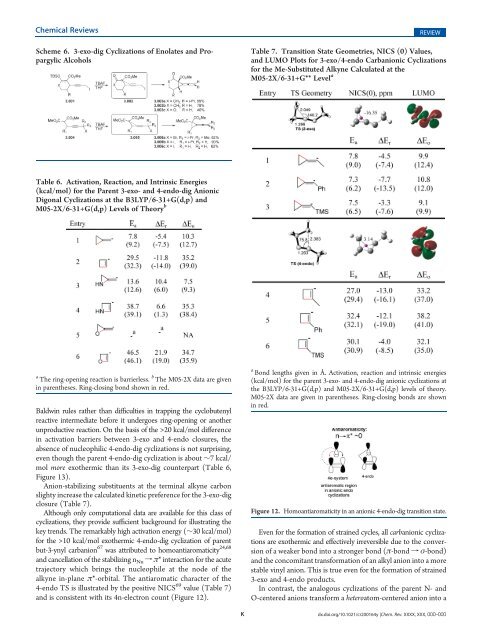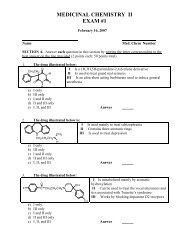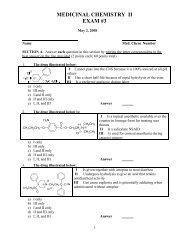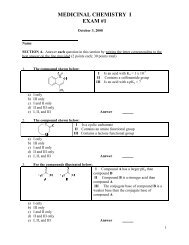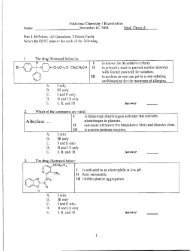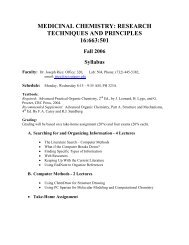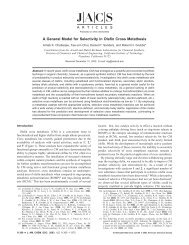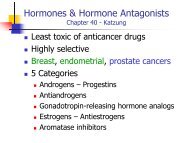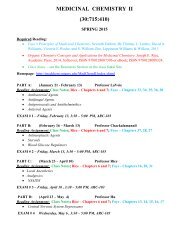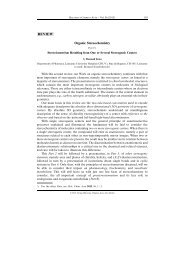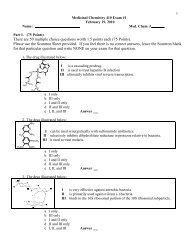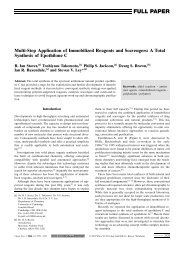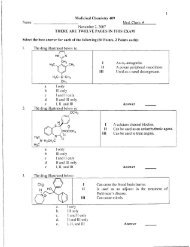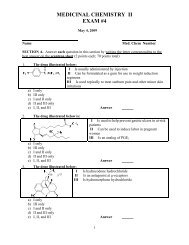Baldwin's Rules - Department of Medicinal Chemistry
Baldwin's Rules - Department of Medicinal Chemistry
Baldwin's Rules - Department of Medicinal Chemistry
Create successful ePaper yourself
Turn your PDF publications into a flip-book with our unique Google optimized e-Paper software.
Chemical Reviews REVIEW<br />
Scheme 6. 3-exo-dig Cyclizations <strong>of</strong> Enolates and Propargylic<br />
Alcohols<br />
Table 6. Activation, Reaction, and Intrinsic Energies<br />
(kcal/mol) for the Parent 3-exo- and 4-endo-dig Anionic<br />
Digonal Cyclizations at the B3LYP/6-31+G(d,p) and<br />
M05-2X/6-31+G(d,p) Levels <strong>of</strong> Theory b<br />
a The ring-opening reaction is barrierless. b The M05-2X data are given<br />
in parentheses. Ring-closing bond shown in red.<br />
Baldwin rules rather than difficulties in trapping the cyclobutenyl<br />
reactiveintermediatebeforeitundergoes ring-opening or another<br />
unproductive reaction. On the basis <strong>of</strong> the >20 kcal/mol difference<br />
in activation barriers between 3-exo and 4-endo closures, the<br />
absence <strong>of</strong> nucleophilic 4-endo-dig cyclizations is not surprising,<br />
even though the parent 4-endo-dig cyclization is about ∼7 kcal/<br />
mol more exothermic than its 3-exo-dig counterpart (Table 6,<br />
Figure 13).<br />
Anion-stabilizing substituents at the terminal alkyne carbon<br />
slighty increase the calculated kinetic preference for the 3-exo-dig<br />
closure (Table 7).<br />
Although only computational data are available for this class <strong>of</strong><br />
cyclizations, they provide sufficient background for illustrating the<br />
keytrends.Theremarkablyhighactivationenergy(∼30 kcal/mol)<br />
for the >10 kcal/mol exothermic 4-endo-dig cyclization <strong>of</strong> parent<br />
but-3-ynyl carbanion 67 was attributed to homoantiaromaticity 24,68<br />
and cancellation <strong>of</strong> the stabilizing n Nu f π* interaction for the acute<br />
trajectory which brings the nucleophile at the node <strong>of</strong> the<br />
alkyne in-plane π*-orbital. The antiaromatic character <strong>of</strong> the<br />
4-endo TS is illustrated by the positive NICS 69 value (Table 7)<br />
and is consistent with its 4n-electron count (Figure 12).<br />
Table 7. Transition State Geometries, NICS (0) Values,<br />
and LUMO Plots for 3-exo/4-endo Carbanionic Cyclizations<br />
for the Me-Substituted Alkyne Calculated at the<br />
M05-2X/6-31+G** Level a<br />
a Bond lengths given in Å. Activation, reaction and intrinsic energies<br />
(kcal/mol) for the parent 3-exo- and 4-endo-dig anionic cyclizations at<br />
the B3LYP/6-31+G(d,p) and M05-2X/6-31+G(d,p) levels <strong>of</strong> theory.<br />
M05-2X data are given in parentheses. Ring-closing bonds are shown<br />
in red.<br />
Figure 12. Homoantiaromaticity in an anionic 4-endo-dig transition state.<br />
Even for the formation <strong>of</strong> strained cycles, all carbanionic cyclizations<br />
are exothermic and effectively irreversible due to the conversion<br />
<strong>of</strong> a weaker bond into a stronger bond (π-bond f σ-bond)<br />
and the concomitant transformation <strong>of</strong> an alkyl anion into a more<br />
stable vinyl anion. This is true even for the formation <strong>of</strong> strained<br />
3-exo and 4-endo products.<br />
In contrast, the analogous cyclizations <strong>of</strong> the parent N- and<br />
O-centered anions transform a heteroatom-centered anion into a<br />
K dx.doi.org/10.1021/cr200164y |Chem. Rev. XXXX, XXX, 000–000


